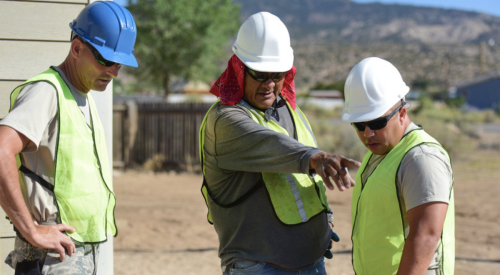|
The Setup: An executive active in land acquisition and development for a large local production builder finds a choice building site on his own, without help from anyone. But then he thinks to himself, "This parcel is so good, we'd gladly pay a broker to get our hands on it."
So instead of approaching the site owner directly, he calls a land broker ... a friend with whom he's comfortable enough to suggest that the broker go after the deal and bring it to him — but only on the condition that the broker splits the commission with the builder's executive in an under-the-table kickback of thousands of dollars.
This is not a hypothetical example of employee theft. It actually happened, and such kickbacks are also not rare. Sales agents have been known to work similar scams with Realtors on referral sales...
Could it happen to you?
If you're like most home builders, at first you say, "No way!" You have complete faith in the honesty and integrity of every person on your senior management team. Actually, you trust every employee in your com-pany. You know them well. Think of them almost as your own extended family. But beware: That's how most builders who are victims of employee theft and insider crime feel right up to the moment evidence forces them to confront the awful truth.
The hurt and sense of betrayal hit first. Then comes the fear that public knowledge of theft and dishonesty in the organization will disastrously impact sales and revenue, perhaps even destroy the company's good name in the community. The hurt and fear, to some extent, explain why so few builders prosecute the criminals who prey upon them. More often than not, they just fire the offender and try to erase the whole nasty episode from their memories. (We've had a tough time getting builders to talk about these events. Even when they do, they usually ask that their names not be used.)
Think about your own experience. We now realize that insider crime is a huge problem in the housing industry. It happens over and over, sometimes because the criminals move from one building company to another — to work the same scam in another part of the country. We believe it happens often enough that most of our readers have either experienced it personally or know someone who has. It's time to put these people in jail.
Brave Builders Tell It Like It Is
"It happens, without question, at every level of the industry, at every level of an organization," D.R. Horton chairman Don Horton says. "We'd all like to think that no one we work with would ever do anything like this, but if you don't think it happens, you'd be a fool. We've got so many assets in this industry, spread over broad geographic areas. I'm not sure you can ever prevent it, but good internal audit departments certainly help. Any medium-sized builder should have an internal audit function, even if it's only one or two people. But make sure those auditors have a good feel for the whole business, not just the numbers side.
"Margins are the biggest tip-off," Horton says. "We watch them closely. If anything looks amiss, we send our auditors. And we tell our division presidents: Never do a land deal without meeting with the seller to verify the terms exactly."
Another GIANT, Toll Brothers chairman Robert Toll, says job site theft — often perpetrated by insiders to the builder's production process, such as trade contractor employees, suppliers and delivery people — is endemic to the building industry. "As long as there are immoral people out there, we'll face it," he says. "To them, it looks like this stuff is there for the taking because it appears unguarded. We have to decide, in the budgeting process, whether it pays to put security on the jobs. We budget $1,000 a unit for job-site theft.
"As for crime by Toll Brothers employees, we have almost none —because when we get it, we go ape. We call the police and take people to court. God forbid anybody ever calls here for a reference on a thief. I'm not afraid of libel or slander. Truth is an absolute defense."
We can't isolate statistics on employee theft and insider crime in the residential construction industry. Even if we could, we'd be looking at only the level of prosecuted crime, which law-enforcement officials (and anecdotal evidence) testify is well short of the actual total. And there's a problem with the diverse nature of crimes committed against builders. Employee theft and fraud would usually (but not always) be categorized as white-collar crime. Job-site theft, the most visible crime against builders, is not white-collar, but more often than not, it's still a form of insider crime. Materials and products disappear from jobs because people who work on those jobs or who deliver the goods know when and where to visit unguarded valuable assets.
But there are national numbers on the costs of white-collar crime throughout the U.S. economy that provide hints on the scope of losses home builders are experiencing. For example, the Association of Certified Fraud Examiners'2000 and 2002 Report to the Nation gives these insights:
- Occupational fraud and abuses fall into three main categories: asset misappropriation, fraudulent statements, bribery and corruption.
- The average organization loses more than $9 a day, per employee, to fraud and abuse.
- The average company loses about 6 percent of total annual revenues to fraud and abuse committed by its own employees.
- The median loss caused by males is about $185,000; by females, about $48,000.
- The typical perpetrator is a college-educated white male.
- Men commit nearly 75 percent of offenses.
- Median losses caused by men are nearly four times those caused by women.
- Losses caused by managers are four times those caused by ordinary employees.
- Median losses caused by senior executives are 16 times those caused by employees.
- The most costly abuses occur in organizations with fewer than 100 employees.
According to John Kane, research manager, and Jeff Lybarger, Internet fraud analyst, both of the National White Collar Crime Center (www. nw3c.org), theft by employees is "two or three times more costly than all of the nation's Type I index crimes combined, and accounts for approximately 30 to 50 percent of all business failures." In addition, NW3C estimates that as many as three-quarters of all employees steal from their employers at least once; some employees "engage in theft behavior as a regular part of their lives on the job."
NW3C reports that the infusion of computer technology into the workplace has only increased the take inside criminals garner from their illegal activities. The average employee embezzlement costs $25,000, but the average computer-assisted employee embezzlement is $430,000, and "coupled with poor controls, it can be manipulated to make detection much more difficult."
NW3C reports only about 40 percent of employees caught stealing are referred for prosecution, while 20 percent are required to make some form of restitution.
Couple statistics such as these for the whole economy with your own knowledge of the unique nature of the housing industry, and we think you'll see the problem in a different light than in the past.
Builders have high-value assets delivered every day to remote building sites. Many of these companies are growing fast, more concerned about how to get the next house built than setting up tight internal controls to monitor their employees and others within the expanding production system. The vast majority of builders have fewer than 100 employees, and the production system always includes far more subcontracted workers than employees. This is a recipe for trouble.
We first became aware of the scope of this problem when Colorado-based computer systems consultant Noelle Tarabulski blew the whistle. "It's happening all over the industry," she says, "I see it a lot. When I get into a company and start dissecting the processes, I find stuff. And a big part of the problem is that the people who pull this stuff go from one company to another because the builders refuse to prosecute."
Construction superintendents are often involved, Tarabulski says. "Supers are building houses on the side, using the builder's trades to do it. That's taking them off-schedule, not to mention the super is using his own time to build these houses instead of the ones the builder is paying him to build."
Kickbacks occur at many different levels of a company, Tarabulski says, but often involve whoever negotiates with, or pays, trades. "I've seen regional presidents in big companies strong-arm even very large trade contractors," she says. "They'll say, 'Every time you build a house, I want $200 deposited in a separate account.' It's always an account that doesn't have a name attached to it. The trades want the work, so they play along."
Long-time consultant and PBcolumnist Chuck Shinn, of Colorado-based Shinn Consulting, verifies Tarabulski's assessment. "The three critical areas where theft happens are accounting, purchasing and the field," Shinn says. "The hardest to catch are the purchasing people.
"You ought to have written policies in place that purchasing can't take anything from vendors or trades — no entertainment, no booze at Christmas, nothing," he says. "If the company accepts those things, they ought to go into a general pool that benefits everyone, not just the purchasing person for that account. Without a policy in place, it starts purchasing people down a slippery road that leads to more serious issues.
"In the field, construction managers and supers should not buy anything," Shinn continues. "It often seems to lead to kickbacks. Purchasing should do the buying, authorization for payment is done by the field, then accounting does the paying. Each of those three areas should act as a check against abuses by the others." In small building companies, keeping functions divided so checks and balances work is hard. "If the company owner authorizes all payments and keeps the books, you just need a different person to do purchasing and another to manage jobs in the field," says Emma Shinn, a partner in Shinn Consulting. "Even a small builder can have that division.
"But what we see most as a violation of checks and balances is purchasing tied into accounting," she continues. "That's a no-no. The controller should not supervise purchasing. Those functions should report separately to senior management. Purchasing negotiates contracts. Operations verifies that work is done according to contract. Accounting processes purchase orders, and senior management signs the checks."
Marketing consultant John Rymer, a former vice president of Atlanta-based Morrison Homes, also agrees with Tarabulski's assessment. "Noelle is right: The industry is rife with corruption. Land development operations are especially vulnerable. We all budget a lot tighter on hard costs than on land because it's hard to isolate all the variables," he says. "Every site is different. With cut-and-fill expenses, for instance, who can say what's necessary, especially after the fact? Is all the pipe the builder paid for really in the ground?"
Atlanta-based people management maven Martin Freedland says he knows a lot of stories. "There are so many scams," he says. "I tell clients to prosecute, but not everybody does it. Firing people and refusing to be a reference are not enough for me. We need to get these people out of the industry. There's a lot going on, and some of it is big money — thousands of dollars."
Freedland says he consulted for a builder in Texas, who said he couldn't figure out why materials and products were going to a strange lot. "The sales manager used dummy vendor accounts to build a home that nobody else knew about," Freedland relates. "The builder didn't prosecute, and the guy ended up working for another builder. Most builders don't even want to talk about these things. They really fear the impact of going public."
Accounting Complexity Can Hurt
Several builders told us how their own organizational complexity, especially the accounting ramifications, allowed someone to perpetrate fraud. The troubling aspect of this is that so many builders have lawyers and estate planners advising just such organizational complexity to protect against liability exposure, or to shelter assets from taxation as they transfer wealth to heirs.
For instance, a builder in the Southeast (who requests anonymity) tells how a multitude of corporate entities — each with different partners — led to trouble. "We had an off-book clearing account," he says. "If a person did work for partnership A and B, we'd keep track of that and issue a check with attribution of a portion of the charge to each. I would sign the checks to the operating account. We had a lady in accounting who reprogrammed our fancy computer to issue more checks than were needed to cover the expenses. When they came back, she'd alter the checks again.
"It was bookkeeping fraud, not unique to the housing industry," this builder continues. "But certainly all those separate entities, which in-creased the accounting complexity, contributed to our vulnerability. My land-development businesses all have different accounts because there are different partners in each, but I also do it for estate purposes. I think a lot of builders do the same thing."
This builder has now changed many aspects of internal control to create checks and balances and more separation of duties. But how many builders have complex organizations — and multiple entities — that more resemble this builder's operations before he was stung by fraud than the tight operation he now runs?
"It's true that every builder I talk to has had some form of employee theft or internal crime happen to them or someone they know," says the builder. "We're all stretched. It's at times like these that things can happen."
|













